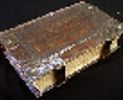.png)
If you have been baptised, or are looking into being baptized, then you will quickly discover that baptism is a public announcement that we are dying to self, being symbolically buried with Christ as you go under the water and then raising with him to a new life, as a new person in Jesus. Washing all your sins away in the water and raising with a clean slate.
So why did Jesus need to be baptised? He was sinless so he didn’t need the baptism of repentance that John his cousin was offering to people. Picture this in your mind, along comes Jesus to be baptized. John says, “Wait, wait! You don’t need me to baptize you. You should baptize me.”
John recognized Jesus as one who didn’t need repentance or forgiveness in baptism. John knew that Jesus was much greater than he was, and that he wasn’t even fit to tie Jesus sandals. And now Jesus wants to be baptized by him? John’s thinking, “This is backwards! This shouldn’t be happening this way!”
Jesus told him it was the right thing to do for righteousness sake? What does he mean? John didn’t invent baptism; John’s immersing people in the “Living waters” of the River Jordan was perfectly within Jewish law and practice at the time. Indeed the Priests had been doing so for Centuries. Ritual washing was commanded, in Exodus 30:17-21, it was ordered that all Priests (Aaron and his sons) undergo ritual washing before they minster before God in the Temple. Jesus was about to begin his ministry, but was not of the line of Aaron, he is of the line of David, so he could not go through the ritual washing in the Temple and instead came to his cousin at the Jordan River.
He did the right thing for one about to minister before God and set an example for those that will follow him, for us, he needed to show us “the way”. Also baptism is as much about death and adoption by God into his family as it is about forgiveness. Jesus is baptised at the beginning of his ministry, preparing him for the death he knows is coming at the end of his ministry, and God speaks from heaven acknowledging Jesus as his Son immediately following his baptism.
 Welcome
Welcome Calendar
Calendar Today's Word
Today's Word Lauds
Lauds Terce
Terce Sext
Sext None
None Vespers
Vespers Compline
Compline Matins
Matins